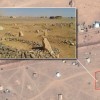« 75,000 Syrians are trapped near Jordan’s border. Satellite images show some are dying. » – par Adam Taylor

Shelters at the Jordan-Syria border by the Rukban crossing, in September 2016. (CNES 2016 Distribution AIRBUS DS)
Over the past five years, Jordan has become one of the biggest recipients of refugees fleeing its war-torn neighbor, Syria. Almost 700,000 Syrians have been registered as refugees in the country, which has a population of just 6.5 million. Those are just the ones who have registered; Jordanian officials say the real number is far over 1 million.
But Jordan’s hospitality may have hit a limit.
In the past year, as the trickle of new refugees entering the country slowed to a crawl, thousands of Syrian refugees have become trapped in an isolated no man’s land between Syria and Jordan known as « the berm. » Current estimates suggest more than 75,000 people are stuck in this area, but Jordanian authorities refused to allow access to the site for journalists and only limited access for aid groups.
A report from Amnesty International published Wednesday evening shows just how dire the situation on the berm has become. Using information from satellite images, video footage and a number of first-person accounts, Amnesty was able to show not only a dramatic growth in the size of the settlement at the border, but also what may be evidence of death and disease at the site.
The satellite imagery appears to show a dramatic growth in shelters at Rukban, one of two border crossings between Syria and Jordan, over the past year. While there were just 363 shelters at the site one year ago by Amnesty’s count, by July 2016 there were 6,563. The most recent imagery released by Amnesty shows 8,295 shelters in September 2016.

Graphic showing the approximate number of shelters at the Syria-Jordan border in September 2016. (CNES 2016, Distribution AIRBUS DS. Data via UNOSAT)
A growing population that is increasingly isolated from food and medical treatment is creating serious health problems, the report noted.
Sources told Amnesty researchers that poor hygiene and sanitation problems at Rukban had led to an outbreak of hepatitis that had killed at least 10 refugees, many of whom were children, since the beginning of June. Aid workers also say that there have been nine childbirth-related deaths since June 21.
Video footage released by Amnesty appears to show graves and burial mounds. The organization also pointed to two separate sites in satellite images that look to be makeshift grave sites at the Rukban crossing. Amnesty said that it was not possible to get a fuller picture of a death toll at the site because of continuing issues with access.

Possible grave site in displacement camp at Syria-Jordan border. (CNES 2016, Distribution AIRBUS DS. Image from video obtained via the Tribal Council of Palmyra)

Image of what appears to be a grave site in displacement camp at Syria-Jordan border. (CNES 2016, Distribution AIRBUS DS. Image from video obtained via the Tribal Council of Palmyra)
“The situation at the berm offers a grim snapshot of the consequences of the world’s abject failure to share responsibility for the global refugee crisis. The . . . effect of this failure has seen many of Syria’s neighbors close their borders to refugees,” said Tirana Hassan, crisis response director at Amnesty.
While it has long been of concern, the situation on the berm appears to have deteriorated noticeably in recent months.
Previously, aid agencies such as the International Committee of the Red Cross in Jordan and the U.N. refugee agency were allowed access to the site to distribute food and provide basic medical services. Refugees were often held up at the border because of stringent security checks by the Jordanian government, but people did get through.
In March, The Washington Post interviewed a number of refugees at the Azraq refugee camp in Jordan, who gave varying accounts of their time there. Some said they had stayed for as many as five months. Often, the families allowed through include women who are in the late stages of pregnancy.
The situation changed when a suicide bombing by the Islamic State killed seven Jordanian border guards near the Rukban crossing on June 21. Jordan had long warned that the Syrian refugees at the border had been infiltrated by extremists; after the bombing, it closed the border for good.
Aid groups lost direct access to the berm. In early August, United Nations aid agencies were forced to use a crane to lower 650 metric tons of food and hygiene kits to the stranded refugees. It was unclear if Jordan would allow more deliveries in the future. « If this continues like it is now, we will soon see starvation, dehydration and we will be confronted with preventable deaths at the berm, » Benoit De Gryse, operations manager for Doctors Without Borders,told reporters.
The Jordanian government has acknowledged the situation at the berm a number of times over the previous year, but justified the tight control at the border because of security concerns about the Islamic State. However, there are also considerable tensions within Jordan over the Syrian refugees who have already arrived in the country. Some Jordanians say these refugees have pushed wages down and prices up. Others point to the considerable amount the government must spend on refugees.
In an interview with the BBC in February, King Abdullah II of Jordan suggested that his country was reaching its limit with refugees, and other nations should not criticize unless they were willing to do more themselves. “If you want to take the moral high ground on this issue, we’ll get them all to an air base and we’re more than happy to relocate them to your country,” he said.